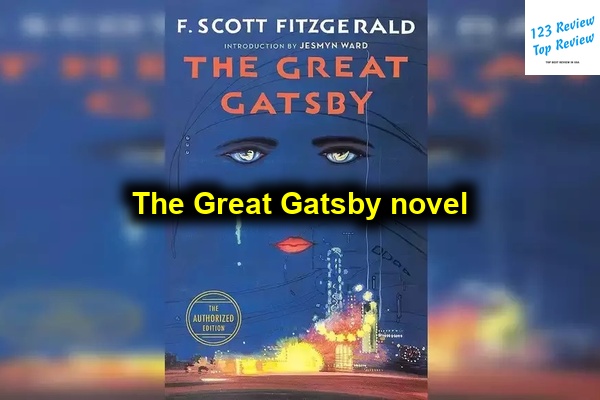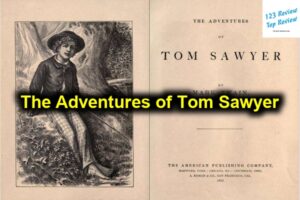Set during the Roaring Twenties, an era characterized by wealth, excess, and cultural upheaval, the Great Gatsby novel explores the pursuit of the American Dream and the devastating consequences of obsession, wealth, and societal expectations. Through its intricate plot, compelling characters, and rich symbolism, The Great Gatsby has become a timeless commentary on ambition, love, and disillusionment.

In this article, 123 Review will explore the major themes, characters, and symbols in the novel, as well as the literary devices Fitzgerald employs to craft this masterpiece. We will also examine its critical reception, influence on American literature, and its place in modern culture, before concluding with its enduring legacy.
Themes in The Great Gatsby
At its core, The Great Gatsby is a novel about the human condition, and Fitzgerald deftly weaves several key themes into its narrative, each of which reflects the era in which it was written as well as universal human concerns.
The American Dream
Perhaps the most prominent theme in The Great Gatsby is the American Dream—the belief that through hard work and determination, anyone can achieve success and prosperity in the United States. Jay Gatsby, the novel’s protagonist, epitomizes this ideal. Born James Gatz to poor farmers in North Dakota, he transforms himself into a wealthy, enigmatic figure through a combination of ambition and shady dealings. Gatsby’s journey from rags to riches, however, is not portrayed as a triumph but rather as a cautionary tale about the dangers of materialism and the hollowness of the American Dream.
Fitzgerald’s portrayal of the American Dream is deeply critical. For Gatsby, wealth is not a means to self-fulfillment but a vehicle for winning back his former love, Daisy Buchanan. His obsession with wealth and status, symbolized by his lavish parties, masks the emptiness of his existence. The novel suggests that the American Dream has been corrupted, with the pursuit of wealth overshadowing the pursuit of happiness, morality, and genuine human connection. Gatsby’s tragic downfall reveals that the American Dream is often unattainable, a mirage that leaves those who chase it disillusioned and broken.
Materialism and Class Disparities
The novel delves into the stark contrasts between different social classes in 1920s America. The world of The Great Gatsby is one where wealth defines status and identity, and Fitzgerald explores the moral and social consequences of this materialism. The characters are divided into two primary social groups: the old money elite, represented by Tom and Daisy Buchanan, and the newly rich, embodied by Gatsby.
Tom Buchanan and his wife, Daisy, live in East Egg, a place associated with inherited wealth and social superiority. Their lives are marked by entitlement and carelessness, as they remain insulated from the struggles of the working class. Gatsby, who lives in West Egg, represents the nouveau riche—a group that, despite its newfound wealth, is still looked down upon by the old-money aristocracy. The Valley of Ashes, a desolate area inhabited by the lower classes, serves as a stark contrast to the affluence of East and West Egg, symbolizing the human cost of the American obsession with wealth.
Through these characters and settings, Fitzgerald critiques the class disparities of his time, revealing how the pursuit of material success often leads to moral decay. The wealthy characters in The Great Gatsby are often selfish, irresponsible, and indifferent to the suffering of others, highlighting the corrupting influence of money on individuals and society.
The Role of Love and Marriage
In addition to its critique of wealth and class, The Great Gatsby is a novel about love—though not in the conventional sense. Love in the novel is intertwined with ambition, illusion, and desire for power. Gatsby’s infatuation with Daisy is less about genuine affection and more about his idealized vision of her, which represents everything he has ever wanted: success, status, and validation. Gatsby is not in love with Daisy as she is, but with the idea of her as the ultimate prize in his pursuit of the American Dream.
Similarly, the marriage between Tom and Daisy Buchanan is not rooted in love but in social status and convenience. Both characters are unfaithful—Tom with Myrtle Wilson, and Daisy with Gatsby—yet they remain bound by their shared wealth and social standing. Marriage in The Great Gatsby is portrayed as a transactional arrangement, reflecting the superficiality of the characters’ relationships.
This theme is further reinforced by the other relationships in the novel, including that of Myrtle Wilson and her husband George. Myrtle’s affair with Tom is motivated by her desire to escape her lower-class life, but it ultimately leads to her tragic death. Through these various depictions of love and marriage, Fitzgerald critiques the way that relationships are often distorted by wealth, ambition, and societal pressures.
Major Characters in The Great Gatsby
Fitzgerald populates his novel with a cast of complex and memorable characters, each of whom plays a crucial role in exploring the novel’s themes. The characters in The Great Gatsby are not merely individuals; they are symbols of larger ideas about wealth, class, love, and ambition.
Jay Gatsby’s Character Arc
Jay Gatsby, born James Gatz, is the novel’s tragic hero. His transformation from a poor, ambitious young man to a wealthy, mysterious figure is the embodiment of the American Dream. Yet, despite his wealth and success, Gatsby is ultimately unfulfilled. His obsessive desire to recreate the past and win back Daisy Buchanan drives his actions throughout the novel, but this dream proves unattainable.
Gatsby’s character arc is marked by a gradual revelation of his true identity. At the beginning of the novel, he is presented as an almost mythic figure—larger than life, hosting extravagant parties at his opulent mansion in West Egg. However, as the story progresses, we learn more about his humble origins, his involvement in illegal activities, and the depth of his obsession with Daisy. Gatsby’s tragic flaw is his inability to let go of the past and accept reality. His idealized vision of Daisy and the life he imagines with her blinds him to the fact that she is not the perfect woman he remembers.
In the end, Gatsby’s downfall is both inevitable and tragic. He is a victim of his own dreams, unable to reconcile his idealized vision of the world with the harsh realities of life. His death at the hands of George Wilson is symbolic of the destruction of the American Dream, as Gatsby’s pursuit of wealth and love leads not to fulfillment, but to ruin.
Nick Carraway as the Observer
Nick Carraway, the novel’s narrator, serves as both a participant and an observer of the events that unfold. His role as the novel’s moral center is complicated by his ambivalence towards the characters around him. At the beginning of the novel, Nick presents himself as a reliable narrator, someone who withholds judgment and observes the world around him with a critical eye. However, as the story progresses, it becomes clear that Nick is far from impartial. His admiration for Gatsby, despite the latter’s flaws, reveals his own moral complexities.
Nick’s character arc is marked by a growing disillusionment with the world of wealth and privilege that he initially finds so alluring. By the end of the novel, he has become deeply critical of the Buchanans and their social circle, recognizing the moral emptiness of their lives. Nick’s final judgment of Tom and Daisy—that they are “careless people” who destroy lives and retreat behind their wealth—serves as a condemnation of the society that Fitzgerald portrays in The Great Gatsby.
Daisy Buchanan’s Complexity
Daisy Buchanan is a character of contradictions. On the surface, she appears to be the quintessential 1920s socialite—beautiful, charming, and carefree. However, beneath this veneer lies a deeply flawed individual. Daisy is both a victim of her circumstances and a willing participant in the corrupt world she inhabits. Her relationship with Gatsby is central to the novel, but it is clear that her love for him is not as pure or as strong as Gatsby believes.
Daisy’s complexity lies in her ability to be both sympathetic and reprehensible. She is trapped in a loveless marriage with Tom Buchanan, yet she lacks the courage to leave him. When faced with the opportunity to be with Gatsby, she chooses the comfort and security of her privileged life over true love. In the end, Daisy is a symbol of the unattainable dream that Gatsby spends his life pursuing—a dream that, like Daisy herself, is ultimately hollow.
Tom Buchanan’s Antagonism
Tom Buchanan, Daisy’s husband, is the novel’s primary antagonist. He represents the worst aspects of the old-money elite—arrogant, entitled, and morally bankrupt. Throughout the novel, Tom’s actions reveal his deep-seated insecurities and his need to assert his dominance over others. His affair with Myrtle Wilson is an example of his disregard for the feelings and well-being of those around him, while his treatment of Gatsby reveals his contempt for those he perceives as beneath him.
Tom’s antagonism is not just personal; it is also symbolic of the class conflicts that run throughout the novel. He sees Gatsby as a threat not only to his marriage but also to the social order that privileges people like him. In the end, Tom’s triumph over Gatsby is not just a personal victory—it is a reaffirmation of the rigid class structures that The Great Gatsby critiques.
Symbolism in The Great Gatsby
Fitzgerald’s use of symbolism in The Great Gatsby is one of the novel’s most notable features. Through recurring symbols, he deepens the novel’s themes and adds layers of meaning to the narrative.
The Significance of the Green Light
The green light at the end of Daisy’s dock is one of the novel’s most enduring symbols. For Gatsby, it represents his hopes and dreams, particularly his desire to be reunited with Daisy. The light is always just out of reach, symbolizing the unattainability of his dream. As the novel progresses, the green light takes on a more universal significance, representing the broader theme of the American Dream itself.
Gatsby’s fixation on the green light reflects his inability to let go of the past and his belief that he can recreate it. The light is a constant reminder of the distance between Gatsby’s dreams and reality—a distance that, no matter how hard he tries, he can never overcome.
The Eyes of Doctor T.J. Eckleburg
Another significant symbol in the novel is the billboard featuring the eyes of Doctor T.J. Eckleburg, which overlooks the desolate Valley of Ashes. These eyes are often interpreted as a representation of God or a moral conscience, watching over the immoral actions of the characters. However, like much of the symbolism in The Great Gatsby, the meaning of the eyes is ambiguous. They may represent the idea that in a world driven by materialism and selfishness, there is no real moral authority.
The eyes of Doctor T.J. Eckleburg are a haunting presence in the novel, serving as a reminder of the consequences of the characters’ actions. They watch silently as the story unfolds, offering no judgment or intervention—an apt symbol for the moral ambiguity that permeates the novel.
The Valley of Ashes
The Valley of Ashes, located between West Egg and New York City, represents the bleak reality of the working class. It is a desolate and grim place, a stark contrast to the opulence of the world inhabited by the Buchanans and Gatsby. The Valley of Ashes symbolizes the consequences of the wealth and excess enjoyed by the novel’s upper-class characters. It is a place where dreams die, and it serves as a grim reminder of the human cost of materialism.
The Valley of Ashes also plays a key role in the novel’s tragic events. It is here that George Wilson lives and works, and it is here that Myrtle Wilson meets her untimely death. The Valley of Ashes is not just a physical location; it is a symbol of the moral and spiritual decay that underpins the novel’s critique of wealth and class.
Writing Style and Literary Devices
Fitzgerald’s masterful use of language and literary devices is one of the reasons The Great Gatsby has endured as a classic. His poetic prose, vivid imagery, and complex narrative structure all contribute to the novel’s lasting impact.
Fitzgerald’s Poetic Prose
Fitzgerald’s writing in The Great Gatsby is characterized by its lyrical, almost poetic quality. His sentences are carefully crafted, often flowing with a rhythm that enhances the emotional tone of the novel. This poetic prose helps to create a sense of nostalgia and longing, particularly in Gatsby’s descriptions of his past with Daisy and his dreams for the future.
Fitzgerald’s language also serves to heighten the novel’s themes of illusion and disillusionment. His use of evocative and symbolic descriptions allows readers to see the world through the eyes of his characters, particularly Gatsby, whose view of reality is often shaped by his idealized vision of the world.
Use of Imagery and Metaphors
Imagery and metaphor are central to The Great Gatsby, adding depth and layers of meaning to the story. The novel is filled with vivid descriptions that evoke the mood and atmosphere of the 1920s, from the glittering parties at Gatsby’s mansion to the bleakness of the Valley of Ashes. These images not only create a rich, immersive world for readers but also serve to reinforce the novel’s themes.
Fitzgerald’s use of metaphors is equally significant. One of the most important metaphors in the novel is Gatsby’s transformation from James Gatz into Jay Gatsby, a metaphor for the idea of self-invention and the American Dream. Gatsby’s reinvention is both a personal and symbolic act, representing the belief that anyone can rise above their circumstances through determination and ambition.
Narrative Structure and Point of View
The narrative structure of The Great Gatsby is one of its most intriguing aspects. The novel is told from the first-person perspective of Nick Carraway, who acts as both a participant in and an observer of the events. This limited point of view adds layers of complexity to the story, as readers are forced to interpret the characters and events through Nick’s subjective lens.
Nick’s role as the narrator raises questions about his reliability. While he presents himself as an objective observer, it becomes clear that his feelings for Gatsby influence his portrayal of the other characters. This ambiguity adds depth to the novel, inviting readers to consider the ways in which perception and reality are often at odds.
Critical Reception of The Great Gatsby
When The Great Gatsby was first published in 1925, it received mixed reviews. Many contemporary critics failed to recognize its literary significance, and the novel’s sales were modest at best. However, in the years following Fitzgerald’s death, The Great Gatsby began to gain recognition as one of the great American novels. Today, it is widely regarded as a masterpiece and is studied in schools and universities around the world.
Initial Reception and Later Recognition
Upon its release, The Great Gatsby was praised by some critics for its style and characterizations, but others were less enthusiastic about its themes and plot. Sales of the novel were disappointing, and Fitzgerald himself was deeply discouraged by its initial reception. It wasn’t until after his death in 1940 that The Great Gatsby began to achieve widespread acclaim.
In the decades that followed, the novel was rediscovered by scholars and critics, who recognized its exploration of the American Dream, its critique of wealth and class, and its innovative use of language and symbolism. Today, The Great Gatsby is considered one of the greatest novels ever written, a classic that has stood the test of time.
Influence on American Literature
The Great Gatsby has had a profound influence on American literature, particularly in its portrayal of the American Dream and its exploration of the tensions between wealth, class, and identity. The novel’s themes have resonated with generations of readers, and its innovative use of language and narrative techniques have inspired countless writers.
Fitzgerald’s influence can be seen in the works of many later American authors, including writers like John Updike and Toni Morrison, who have explored similar themes of identity, ambition, and the American experience. The Great Gatsby’s critique of materialism and its depiction of the moral decay of the wealthy elite continue to be relevant in contemporary literature and culture.
The Great Gatsby in Modern Context
Even nearly a century after its publication, The Great Gatsby remains relevant in today’s world. Its themes of wealth, power, and social mobility continue to resonate, particularly in an era where income inequality and the pursuit of success remain central concerns. The novel’s critique of the American Dream is as poignant as ever, reflecting the disillusionment that often accompanies the pursuit of wealth and status.
In addition to its thematic relevance, The Great Gatsby has become a cultural touchstone, referenced in everything from fashion and music to social media. The novel’s iconic imagery, such as Gatsby’s parties and the green light, have become symbols of excess and aspiration in popular culture.
Adaptations and Cultural Impact
The Great Gatsby has been adapted numerous times for film, television, and stage, with each adaptation offering a unique interpretation of the novel’s themes and characters.
Film Adaptations and Comparisons
One of the most famous adaptations of The Great Gatsby is the 1974 film directed by Jack Clayton and starring Robert Redford as Gatsby and Mia Farrow as Daisy. This version is noted for its faithful adaptation of the novel’s plot and its lavish production design, which captures the opulence of Gatsby’s world. However, some critics felt that the film lacked the emotional depth and complexity of the novel.
In 2013, Baz Luhrmann directed another adaptation of The Great Gatsby, starring Leonardo DiCaprio as Gatsby and Carey Mulligan as Daisy. This version is known for its bold, visually stunning style and its use of modern music to evoke the decadence of the 1920s. While Luhrmann’s adaptation received mixed reviews, it introduced the novel to a new generation of viewers and reignited interest in Fitzgerald’s work.
The Great Gatsby in Popular Culture
Beyond its film adaptations, The Great Gatsby has permeated popular culture in numerous ways. The novel’s imagery and themes have been referenced in music, fashion, and even social media. Gatsby’s extravagant parties, in particular, have become synonymous with the idea of excess and indulgence, often invoked to describe contemporary luxury lifestyles.
The novel’s themes of ambition, disillusionment, and the pursuit of the American Dream have also made it a frequent point of reference in political and social commentary. In times of economic inequality and political upheaval, The Great Gatsby continues to serve as a powerful critique of the American Dream and the moral consequences of materialism.
Critical Discussions in Academic Circles
In academic circles, The Great Gatsby is the subject of extensive critical analysis. Scholars have explored the novel from a variety of perspectives, including its exploration of identity, morality, and societal critique. Some critics focus on the novel’s use of symbolism, while others analyze its narrative structure and character development. The novel’s ambiguous ending, in particular, has been the subject of much debate, with different interpretations offered about Gatsby’s ultimate fate and the meaning of the green light.
Conclusion on The Great Gatsby‘s Legacy
Enduring Relevance of Themes
The themes of The Great Gatsby—the pursuit of the American Dream, the corrupting influence of wealth, the complexities of love and identity—remain as relevant today as they were in the 1920s. Fitzgerald’s critique of materialism and the moral emptiness of the wealthy elite continues to resonate in a world where income inequality and the quest for success dominate much of modern life.
Gatsby’s tragic story serves as a timeless reminder of the dangers of living in pursuit of an unattainable ideal. His dream of reclaiming the past and achieving a perfect future with Daisy is ultimately doomed, and his downfall serves as a cautionary tale about the limits of ambition and the illusions of the American Dream.
Continued Study and Celebration
As one of the most studied and celebrated works of American literature, The Great Gatsby continues to captivate readers and scholars alike. Its richly layered narrative, complex characters, and evocative symbolism offer endless opportunities for interpretation and analysis. Whether through classroom study, literary criticism, or cultural references, The Great Gatsby remains a central part of the American literary canon.
F. Scott Fitzgerald’s The Great Gatsby is more than just a novel; it is a reflection of the aspirations, disillusionments, and contradictions of the American experience. Its enduring relevance ensures that it will continue to be read, studied, and admired for generations to come.
Final Thoughts
The Great Gatsby stands as one of the most iconic and influential works of American literature, offering a timeless exploration of the human condition. Through its intricate symbolism, complex characters, and lyrical prose, the novel delves into the heart of the American Dream, revealing both its allure and its dangers. As readers continue to engage with Gatsby’s story, the novel’s relevance only grows stronger, reminding us of the enduring power of literature to reflect the world around us.





